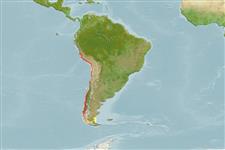Common names from other countries
Classification / Names / Names
Namen | Synonyme | Catalog of Fishes (gen., sp.) | ITIS | CoL | WoRMS
Environment: milieu / climate zone / depth range / distribution range
Ökologie
; tiefenbereich 10 - 1138 m (Ref. 87391). Temperate; 11°S - 54°S, 78°W - 68°W
Southeast Pacific and Southwest Atlantic: Chile and Peru.
Length at first maturity / Size / Gewicht / Alter
Maturity: Lm ? range ? - ? cm Max length : 15.0 cm CW Männchen/unbestimmt; (Ref. 78814); 11 cm CW (female)
Found on soft-bottom sublittoral habitats. Mainly epifaunal but can be considered a bioturbator as it reworks sediments. Notably disturbs the sea floor, exhibiting "sediment mining" behavior while in search of prey. Predatory (Ref. 106462).
Life cycle and mating behavior
Geschlechtsreife | Fortpflanzung | Ablaichen | Eier | Fecundity | Larven
Members of the order Decapoda are mostly gonochoric. Mating behavior: Precopulatory courtship ritual is common (through olfactory and tactile cues); usually indirect sperm transfer.
Gorny, M. 1999. (Ref. 87391)
IUCN Rote Liste Status (Ref. 130435)
CITES Status (Ref. 108899)
Not Evaluated
Not Evaluated
Bedrohung für Menschen
Harmless
Nutzung durch Menschen
Fischereien: kommerziell
FAO - Fischereien: landings | FishSource | Sea Around Us
Tools
Mehr Information
Alter/GrößeWachstumLänge-GewichtLänge-LängeMorphologieLarvenDichte
Internet Quellen
Estimates based on models
Preferred temperature
(Ref.
115969): 6.5 - 12.3, mean 9.4 (based on 36 cells).
